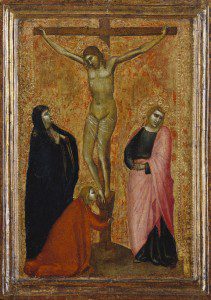Over the Christmas season, we naturally hear so much about Jesus’s mother, Mary, and in conversations, I am always a bit taken aback (not to mention amused) to find how many of the popular stories circulating her actually derive from ancient apocryphal sources. Sorry, no, she wasn’t a Temple Virgin, set aside for her special purity. What we can actually say with confidence about Mary is surprisingly limited, and most of what we do say is drawn from an unconscious blending of several sources that actually present quite distinct accounts.
Looking at how Mary’s story developed raises interesting questions about how far we can use negative evidence. Just to take the birth story as a familiar example, Matthew has kings, Luke has shepherds, and we put them together to make the Christmas scene we all know. But what does it mean that Luke does not report kings, and Matthew says nothing about shepherds? When can we assume that not saying something implies not knowing it? And as I’ll show, those absences go far beyond the minutiae of the Christmas story. Briefly, what do our various sources say about Mary overall, and what do they not say?
To begin with a chronology of sources, which is where all historical arguments must start. There are four canonical gospels, and they can be very roughly dated as follows:
Mark – early 70s AD
Matthew and Luke – c.85-95
John – around 100 AD in complete form
Those dates apply to advanced or near final editions, and those works would certainly involve older levels and layers. But for the sake of argument, let’s take those dates as reasonably accurate.
As we will know from any number of church readings over the past week or two, references abound in both Matthew and Luke, mainly concerning Jesus’s conception and birth. But look at the older account that both those evangelists use as a source. What did Mark say around the 60s and 70s? Really, next to nothing.
As is well known, Mark has no birth story, but Mary scarcely appears even as a character. In one story, Jesus’s family are alarmed by the attention he has been receiving as a preacher and healer, and in modern terms, they stage an intervention. “His brethren and his mother” call to him, earning Jesus’s remarkably cool-sounding response that whoever does the will of God is his brother, and his sister, and his mother. In that instance, the mother is not even named, but a little later, a crowd identifies Jesus as “the son of Mary, the brother of James, and Joses, and of Judah, and Simon.” And that’s it.
What you can argue reliably from Mark is that Jesus had a mother who was still alive and active during his ministry, but had nothing particular to do with that career. The reader might deduce that Jesus’s relations with his family were strained, at best. Based on Mark alone, we can say nothing about special circumstances surrounding his birth. Surely, surely, if he knew that story, he would have used it.
Was that really all that Mark (and his particular Christian community) knew about Mary at that time?
A decade or two later, Matthew has expanded the story to incorporate the miraculous conception, the birth at Bethlehem, the massacre of the innocents, and the flight into Egypt. Even so, Mary’s career extends only to the fact that she and the family try to intervene, as reported in Mark; and also that the crowd know Jesus as the son of Mary. As in Mark, there is no suggestion that Mary had anything to do with Jesus’s ministry, or that she ever left Galilee after that last encounter.
That is very much the same picture that we hear a few years afterwards in Luke, or at least in his gospel. Luke has some childhood stories, but not the massacre of the innocents or the flight into Egypt. Remove those childhood stories, and you are left with a Mary who is as much a cipher as in Mark.
However, Luke does add one really surprising reference in his subsequent work Acts, namely that Mary was present among the first apostles in Jerusalem (1.14). This is wholly unexpected in terms of what has gone before in any of the gospels. Nor does that isolated text have any sequel. One reason for Mary’s appearance here might be that Luke needs at least one early reference to her to support the parallel structures and symmetries that are so often noted between his two books. Through history, though, Mary has often occupied center stage in artistic visions of Pentecost.
This image is in the public domain
Mary is not mentioned in any of Paul’s epistles, all of which were written before any of the gospels.
By this point, you may be wondering why I am leaving out some of the most moving tales involving Mary, namely her presence at her son’s crucifixion. That is, after all, a standard feature of so many thousand paintings throughout the centuries, not to mention so many versions of the Pietà. All three Synoptics list a number of women present at that event, and also at the subsequent burial and Resurrection. They list different names, including multiple Marys, but none mentions the Virgin Mary. Matthew, for instance, lists Mary Magdalene and “the other Mary,” but in the context, this is clearly “Mary the mother of James and Joses.”
This image is in the public domain
Everything we know about Mary being at the crucifixion comes from one source, namely John’s gospel. The Synoptics say nothing about this.
So to return to that initial question about negative evidence. If indeed our Mary was at the crucifixion, why does no other writer besides John mention the fact, when surely it would fit naturally into their stories? How likely is it that they knew the story, but decided to omit it? Why does the story not appear in any account before the end of the first century?
Why, similarly, does Mary feature barely at all in Mark, or indeed in any source that we can plausibly date before 80 AD – a full half a century after the events described? There are multiple possibilities, but let me highlight three:
One is that the Mary stories developed over time as legendary accretions as an expanding church speculated about Jesus’s origins and “back-story.” To illustrate how that process continued, somewhere around 170, the Protevangelium was creating and popularizing so many of the later-popular Mary stories (including the one about her being a Temple Virgin).
Alternatively, the stories we find in John, Luke and Matthew were genuinely early, but they were known only in some parts of the world, some sections of the church, rather than others, so perhaps some writers simply did not know them to transmit them. Luke certainly suggests that he has access to a narrative tradition stemming from Mary personally.
Or thirdly, just hypothetically, perhaps the gospel writers deliberately withheld some stories that they did know, which they held back to be passed on orally to candidates for entry into the church as they became ready to hear them.
Did Mark not know, not care, or not say?
Any of those possibilities might be accurate, or perhaps there are other explanations I am simply neglecting. But the point is that the accounts of Mary found in the various traditions do differ very substantially, and those differences demand some thought, and explanation. They also show how vital a role tradition, rather than scripture, plays in shaping Christian belief and doctrine.














